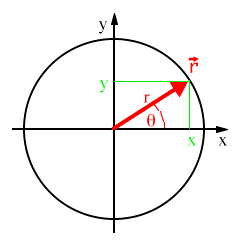

To describe the two-dimensional position vector, ![]() ,
in circular motion it is not convenient to work in cartesian
(x and y) coordinates.
,
in circular motion it is not convenient to work in cartesian
(x and y) coordinates.
Rather: Introduce Polar Coordinates, r and q,
where r is the length of the vector ![]() ,
and
,
and
Transformation from cartesian to polar:
Transformation from polar to cartesian:
y = r sin
Big advantage: r does not change during circular
motion. This leads to motion that can be described using the angle
Even though the motion is in a two-dimensional plane, circular motion can be described as one-dimensional.